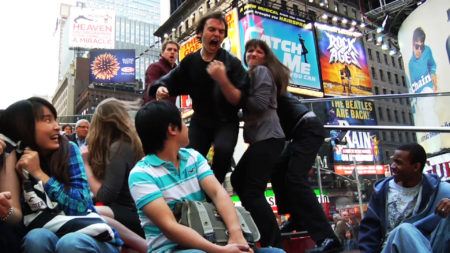Continue playing
(Time remaining: )
Play from beginning
Continue playing "{{ controller.videos[controller.getVideo(controller.currentVideo)].segmentParentTitle}}"
{{controller.videos[controller.getVideo(controller.currentVideo)].title}} has ended.
"Broken Bridge II"El Anatsui
Filmed in late 2012 and early 2013, Nigeria-based artist El Anatsui discusses his large-scale sculpture Broken Bridge II (2012) and the importance of its location on an east-facing wall above the High Line, a relatively new park located on once-abandoned, elevated railroad tracks on Manhattan’s west side. By incorporating mirrors into Broken Bridge II, a new material for the artist, Anatsui is able to reflect and point out characteristics of New York that he considers iconic.
High Line Art’s project manager Jordan Benke and curator Cecilia Alemani discuss the installation process and how this work differs from Anatsui’s smaller sculptures. Broken Bridge II will be on view through September 2013.
Credits
Producer: Ian Forster. Consulting Producer: Wesley Miller & Nick Ravich. Interview: Ian Forster. Camera: Ian Forster. Sound: Stephanie Andreou. Editor: Morgan Riles. Music: Henry Terepka. Time-lapse Courtesy: High Line Art. Artwork Courtesy: El Anatsui, High Line Art & Jack Shainman Gallery. Special Thanks: Friends of the High Line. Theme Music: Peter Foley.
Closed captionsAvailable in English, German, Romanian, Italian, Japanese, Korean, Chinese, Italian
Through the Art21 Translation Project, multilingual audiences from around the globe can contribute translations, making Art21 films more accessible worldwide. Translate this video now.
Interested in showing this film in an exhibition or public screening? To license this video please visit Licensing & Reproduction.
El Anatsui’s sculptures are mutable in form, conceived to be so free and flexible that they can be shaped in any way and altered in appearance for each installation. Working with wood, clay, metal, and—most recently—the discarded metal caps of liquor bottles, Anatsui breaks with sculpture’s traditional adherence to forms of fixed shape while visually referencing the history of abstraction in African and European art. The colorful and densely patterned fields of the works assembled from discarded liquor-bottle caps also trace a broader story of colonial and postcolonial economic and cultural exchange in Africa, told in the history of cast-off materials. The sculptures in wood and ceramics introduce ideas about the function of objects (their destruction, transformation, and regeneration) in everyday life, and the role of language in deciphering visual symbols.
El Anatsui
El Anatsui
El Anatsui
“I come from a place where I have a lot of sky. The sky starts from ground level, and then goes up. But over here, you have to really look up to realize that there is eventually sky…
That is the experience of most people who lived in the open country and come to New York. Sky is not a common commodity.”
El Anatsui
Public Art
Martin Puryear




